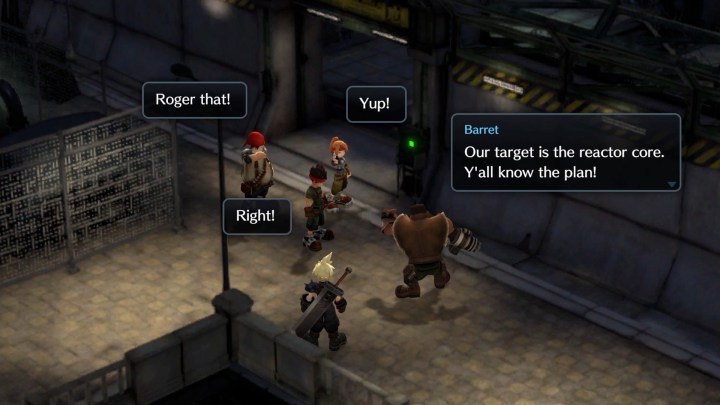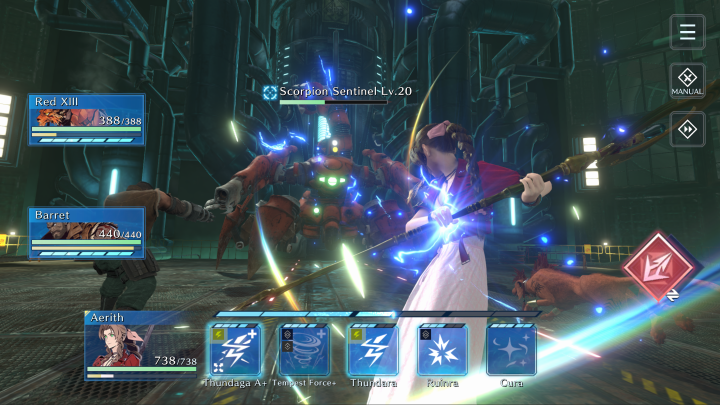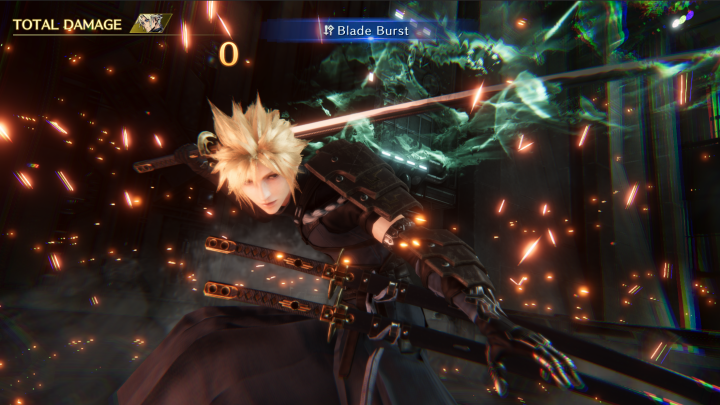When Final Fantasy VII Remake launched in 2020, it was a revelation for me. The bold reimagining taught me that a video game remake can be much more than a nostalgic revisit, instead using the history of the original to tell a high-concept story about destiny. Though I immediately revered it as one of gaming’s greatest accomplishments, others weren’t so pleased. There’s a not-so-small collection of purists out there who simply wanted a 1:1 remake of the PlayStation version with pretty graphics.
Fortunately for that crowd, Square Enix is delivering that faithful remake with Final Fantasy VII Ever Crisis. Well, maybe not as faithful as you’re expecting.
Ever Crisis is an ambitious mobile game that looks to remake not just Final Fantasy VII, but all of its spinoffs too. That includes everything from the recently remade Crisis Core to Advent Children. I’ve been curious about the project ever since it was announced, but I struggled to understand how Square Enix would go about remaking hundreds of hours of content and distilling that into one compilation. After playing several hours of Ever Crisis’ closed beta test, I know the answer to that question, but it’s not exactly what I expected.
If you’re still hoping for that faithful PS1 remake, keep pining. Instead, Final Fantasy VII Ever Crisis only appears to use the Cliff Notes of its source material to power a typical gacha game, albeit one sporting some deep RPG hooks. If Final Fantasy VII Remake was a strong case for video games as art, Ever Crisis is Square Enix in pure commerce mode.
CliffsNotes
Before starting the beta, I only had guesses as to how Ever Crisis would work. I assumed I’d be able to play through full remakes of its included games laid out in roughly chronological order. That’s not exactly the case though. When I log in, I can access a story missions tab which lets me choose games (the beta included snippets from Final Fantasy VII, Crisis Core, and The First Soldier). The stories of each game are split up into bite-sized missions, some of which are no longer than a minute in length. Some are just quick cutscenes to move the narrative along, while others include a hit of exploration, a few battles, and an occasional boss.

The most important thing to understand is that you’re not getting full-on remakes here. I’d start my Final Fantasy VII adventure by watching Cloud hop off a train into Midgar before flashing forward in the North Mako Reactor. Within a few minutes, I was fighting its Guard Scorpion. When that ended, a bomb countdown started and I assumed I’d have to run out of the facility in time, just like the original. Instead, I flashed forward to around six minutes for some dialogue, and then to 30 seconds just in time to watch everyone escape in a cutscene.
I only get to see major plot beats after that. I meet Aerith in Midgar’s streets and get a stiff drink from Tifa at the Seventh Heaven, but there’s not much interstitial content between them. I’ll only get an occasional title card briefly summarizing what happened between big scenes. That’s great news if you’re looking for a much shorter and more succinct way to revisit Final Fantasy VII’s sprawling story, but it’s not as helpful if you’re looking to experience it for the first time here. You’re only getting the broad strokes based on the missions I’ve played so far.
The story content that’s included isn’t always faithful either. In one mission, I need to help Wedge find his lost cat Candy. I walk through the streets, kill some random Shinra guards, and then find the feline wandering around. Mission accomplished?

The presentation of it all adds to some of my initial confusion. When I first boot it up, I’m treated to an epic Sephiroth clash that looks like it was pulled out of Final Fantasy VII Remake complete with full voice acting. When I jump into Final Fantasy VII, I’m looking at something that more closely resembles an HD remake of the PS1 game with no voice acting at all. Battles kick me into that more modern style, leaving me constantly ping-ponging between its two graphical directions.
While the closed beta included a sizable chunk of story, I’ve yet to see what I think will ultimately draw me into the project the most. I’m enticed by the idea of seeing the later parts of VII or more obscure side games like Dirge of Cerberus. Those pieces will require more work, as the developers can’t simply rely on assets from the series’ recent Midgar-centric remakes. That’s where I imagine Ever Crisis will ultimately be most valuable as a remake compilation, but we’ll have to wait to see how that’s executed.
Got ya!
While its piecemeal approach to narrative leaves me with some question marks, combat is fortunately stronger. Ever Crisis riffs on Final Fantasy VII’s active time battle system in a way that’s well-built for mobile. While characters will auto-battle with their basic attacks, each party member has an energy bar that continually fills up during battles. That energy can be spent on different spells and attacks for each character that I can execute by tapping icons at the bottom of the screen. It’s a tactile system that lets me easily direct the flow of battle and manage three characters at once with ease. The Airbuster fight becomes a challenging tactical battle, as I preserve some energy so I can target its weaknesses during charge-up attacks and unleash limit breaks when I stagger it. There’s even an automatic option available for anyone who wants to play it like a full auto-battler.

Though that core battle system is promising, there’s an unfortunate catch to it. When Ever Crisis was first announced, its mobile-only release plan raised some eyebrows. I immediately figured Square Enix must have some monetization plan in mind, but I couldn’t really picture how that would work. Unsurprisingly, it turns out Ever Crisis is a full-on free-to-play gacha game that has players spending real money to draw weapons. How does that work in the context of a story-driven remake? You might not like the answer.
Ever Crisis is a deep RPG where characters from across every included game can be outfitted with weapons and Materia. Each equipped piece of gear raises their overall power level, a number that needs to be raised to keep up with all story missions and side content. Characters naturally level up during missions, which raises their stats in a traditional RPG way, but a chunk of power level is determined by weapon rank and upgrades that are performed with collected materials like whetstone.
How do you get high-rank weapons worth upgrading? Through gacha-style pulls, of course. During the beta period, I’d spend tons of crystals and draw tickets in pursuit of five-star weapons for my party members. At first, it seemed somewhat harmless. I had tons of materials to spend and I was always keeping pace with the story missions’ recommended power level without making a ton of pulls. Then I’d hit the dreaded wall.
The deeper I got into Crisis Core, the more I found it hard to keep Zack’s power level up to speed with what was recommended. I eventually hit the game’s big Ifrit fight and found that there are limits to the combat system. I was simply too weak to survive and it didn’t seem like any battle strategy could fix that. I’d start grinding through some side dungeons and replaying completed missions to try and raise his level, but that process felt sluggish. That’s when I got the bug: “What if I could get a five-star weapon for Zack?” I went to the draw shop and started spending every resource I had, hoping I would get a powerful weapon that would give me the boost I needed to tackle a single mission. I managed to get some great pulls for Red XIII and Aerith but had no luck with Zack. I imagine that’s where I’d have to decide whether or not it was time to spend real money in the full game.

The decision to tie microtransactions to power instead of just cosmetics (costumes are available via draws as well) is a major disappointment, especially considering how fast I’m already hitting insurmountable difficulty spikes. Diablo Immortal is plagued with similar power-centric microtransactions, but I’m at least able to get through its full campaign without spending a dime. Ever Crisis seems a bit more aggressive so far, trying to push me into spending during early story missions instead of its glut of high-level endgame content like dungeons and weapon enhancement quests. I’m sure fans of games like Honkai Star Rail will have an easier time swallowing it all, but I can only hope that balance gets an adjustment based on beta feedback.
If you were hoping Final Fantasy VII Ever Crisis would be the anti-Final Fantasy VII Remake, you’re in luck — but be careful what you wish for. The latter presented players with a bold reimagining that asked players to think deeper about what it actually means to retell a story. It spat in the face of cheap fan service in order to deliver a meta-meditation on destiny and our ability to escape it. Ever Crisis, on the other hand, has nothing new to say about Final Fantasy VII‘s legacy. Instead, it’s built to capitalize on the very nostalgia Remake rejected. This is Final Fantasy as pure product.
That’s not inherently a bad thing. For those who love gacha games, Ever Crisis is shaping up to be a high-quality, free-to-play mobile RPG that gets a lot of mileage out of the franchise’s world and characters. I imagine I’ll hop into the full game when it launches to quickly fill in some of the gaps in the extended franchise universe, especially as I look to refresh myself ahead of Final Fantasy VII Rebirth. You just need to understand what you’re getting yourself into before committing to it. You’re not exploring an art gallery; you’re perusing its gift shop.
Editors' Recommendations
- Tribeca Games 2024 will feature 7 games and a Final Fantasy 7 panel
- Final Fantasy VII Rebirth makes one impactful change to Barret’s story
- Like the best RPGs, Final Fantasy VII Rebirth gets sidequests right
- Final Fantasy VII Rebirth isn’t on Xbox, so play these RPGs on Game Pass
- Whatever you do, don’t skip Final Fantasy VII Rebirth’s card minigame




